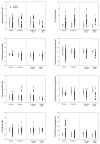Platelet serotonergic markers as endophenotypes for obsessive-compulsive disorder
- PMID: 15886722
- PMCID: PMC1885456
- DOI: 10.1038/sj.npp.1300752
Platelet serotonergic markers as endophenotypes for obsessive-compulsive disorder
Abstract
Although compelling evidence has shown that obsessive-compulsive disorder (OCD) has a strong genetic component, its genetic basis remains to be elucidated. Identifying biological abnormalities in nonaffected relatives is one of the strategies advocated to isolate genetic vulnerability factors in complex disorders. Since peripheral serotonergic disturbances are frequently observed in OCD patients, the aim of this study was to investigate if they could represent endophenotypes, by searching for similar abnormalities in the unaffected parents of OCD patients. We assessed whole blood serotonin (5-HT) concentration, platelet 5-HT transporter (5-HTT) and 5-HT2A receptor-binding characteristics, and platelet inositol trisphosphate (IP3) content in a sample of OCD probands (n = 48) and their unaffected parents (n = 65), and compared them with sex- and age-matched controls (n = 113). Lower whole blood 5-HT concentration, fewer platelet 5-HTT-binding sites, and higher platelet IP3 content were found in OCD probands and their unaffected parents compared to controls. Whole blood 5-HT concentration showed a strong correlation within families (p < 0.001). The only parameter that appeared to discriminate affected and unaffected subjects was 5-HT2A receptor-binding characteristics, with increased receptor number and affinity in parents and no change in OCD probands. The presence of peripheral serotonergic abnormalities in OCD patients and their unaffected parents supports a familial origin of these disturbances. These alterations may serve as endophenotypic markers in OCD, and could contribute to the study of the biological mechanisms and genetic underpinnings of the disorder.
Figures

Similar articles
-
Platelet serotonergic predictors of clinical improvement in obsessive compulsive disorder.J Clin Psychopharmacol. 2004 Feb;24(1):18-23. doi: 10.1097/01.jcp.0000104905.75206.50. J Clin Psychopharmacol. 2004. PMID: 14709942 Clinical Trial.
-
Platelet serotonin transporter in children and adolescents with obsessive-compulsive disorder or Tourette's syndrome.J Am Acad Child Adolesc Psychiatry. 1996 Dec;35(12):1647-56. doi: 10.1097/00004583-199612000-00017. J Am Acad Child Adolesc Psychiatry. 1996. PMID: 8973072 Clinical Trial.
-
Decreased platelet 3H-paroxetine binding in obsessive-compulsive patients.Neuropsychobiology. 1996;34(4):184-7. doi: 10.1159/000119308. Neuropsychobiology. 1996. PMID: 9121618
-
Platelet serotonin-2 receptors in obsessive-compulsive disorder.Biol Psychiatry. 1993 Mar 1;33(5):367-72. doi: 10.1016/0006-3223(93)90326-9. Biol Psychiatry. 1993. PMID: 8471695 Review.
-
A review of the efficacy of selective serotonin reuptake inhibitors in obsessive-compulsive disorder.J Clin Psychiatry. 1999 Feb;60(2):101-6. doi: 10.4088/jcp.v60n0206. J Clin Psychiatry. 1999. PMID: 10084636 Review.
Cited by
-
Untargeted metabolomics analysis in drug-naïve patients with severe obsessive-compulsive disorder.Front Neurosci. 2023 Jun 2;17:1148971. doi: 10.3389/fnins.2023.1148971. eCollection 2023. Front Neurosci. 2023. PMID: 37332872 Free PMC article.
-
Relevance of orbitofrontal neurochemistry for the outcome of cognitive-behavioural therapy in patients with obsessive-compulsive disorder.Eur Arch Psychiatry Clin Neurosci. 2012 Oct;262(7):617-24. doi: 10.1007/s00406-012-0304-0. Epub 2012 Mar 17. Eur Arch Psychiatry Clin Neurosci. 2012. PMID: 22427151
-
Cerebral chemoarchitecture shares organizational traits with brain structure and function.Elife. 2023 Jul 13;12:e83843. doi: 10.7554/eLife.83843. Elife. 2023. PMID: 37440423 Free PMC article.
-
Tail biting in pigs: blood serotonin and fearfulness as pieces of the puzzle?PLoS One. 2014 Sep 4;9(9):e107040. doi: 10.1371/journal.pone.0107040. eCollection 2014. PLoS One. 2014. PMID: 25188502 Free PMC article.
-
Glutamate abnormalities in obsessive compulsive disorder: neurobiology, pathophysiology, and treatment.Pharmacol Ther. 2011 Dec;132(3):314-32. doi: 10.1016/j.pharmthera.2011.09.006. Epub 2011 Sep 22. Pharmacol Ther. 2011. PMID: 21963369 Free PMC article. Review.
References
-
- Alsobrook IJ, Leckman JF, Goodman WK, Rasmussen SA, Pauls DL. Segregation analysis of obsessive-compulsive disorder using symptom-based factor scores. Am J Med Genet. 1999;88:669–75. - PubMed
-
- Alvarez JC, Gluck N, Arnulf I, Quintin P, Leboyer M, Pecquery R, et al. Decreased platelet serotonin transporter sites and increased platelet inositol triphosphate levels in patients with unipolar depression: effects of clomipramine and fluoxetine. Clin Pharmacol Ther. 1999;66:617–24. - PubMed
-
- Arolt V, Lencer R, Nolte A, Muller-Myhsok B, Purmann S, Schurmann M, et al. Eye tracking dysfunction is a putative phenotypic susceptibility marker of schizophrenia and maps to a locus on chromosome 6p in families with multiple occurrence of the disease. Am J Med Genet. 1996;67:564–79. - PubMed
-
- Barr LC, Goodman WK, Price LH, McDougle CJ, Charney DS. The serotonin hypothesis of obsessive compulsive disorder: implications of pharmacologic challenge studies. J Clin Psychiatry. 1992;53(Suppl):17–28. - PubMed
-
- Bastani B, Arora RC, Meltzer HY. Serotonin uptake and imipramine binding in the blood platelets of obsessive-compulsive disorder patients. Biol Psychiatry. 1991;30:131–9. - PubMed
Publication types
MeSH terms
Substances
LinkOut - more resources
Full Text Sources
Medical

